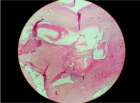Table of Contents
Molecular Mechanisms and Potential Predictive Biomarkers in Advanced Non-small Cell Lung Cancer: A Summary of Current and Future Trends
Published on: 27th June, 2024
Non-small-cell lung cancer (NSCLC) accounts for 85% of lung cancer cases and is associated with different risk factors (smoking habits, gender, and age). In this scenario, many studies have been conducted to pursue improvement of survival, faster and better therapy response, reduced adverse events, and expanded available therapies and treatments against tumor resistance to drugs. These studies have focused on defining the most prevalent NSCLC biomarkers (EGFR, HER2, ALK, MET, ROS1, BRAF, KRAS G12C, HER3, NTRK, and NRG1) and their actionability. It is noteworthy that expressed kinase receptors can have overlapping mechanisms of activation of different pathways (JAK-STAT, MAPK, PI3K-AKT-mTOR, and PLC-c), which can lead to the same outcome of cell proliferation, migration, and survival resulting in increased tumor resistance to treatment. This review provides an overview of the latest findings regarding NSCLC treatment, emphasizing particular biomarkers and potential molecularly altered pathways implicated as targeted therapies. Additionally, it explores the clinical significance of the proposed treatments, their implication on progression-free survival, ongoing clinical trials, and their perspective of evolution so far.
Non-invasive Serological Markers of Hepatic Fibrosis – Mini Review
Published on: 14th May, 2024
Aim: This study examines the pathological outcomes of chronic liver injuries, with a focus on liver fibrosis. It emphasizes understanding the structural changes within the liver that may lead to cirrhosis and functional impairments, crucial for developing targeted antifibrotic therapies.Methods: Our approach reviews existing literature detailing the use of traditional diagnostic methods—biochemical and serological tests alongside liver biopsies. Additionally, we evaluate the reliability and efficacy of non-invasive techniques such as serological test panels and imaging examinations. These methods are compared to understand their viability as supplementary or alternative diagnostic tools to liver biopsy.Significance: Liver fibrosis, if unmanaged, can progress to severe conditions such as cirrhosis and hepatocellular carcinoma, making it vital to understand its progression and treatment options. This study underscores the need for precise and non-invasive diagnostic tools in the clinical management of liver fibrosis, providing insight into the progression of chronic liver diseases and potential therapeutic targets.Conclusion and future perspectives: The research confirms that while liver biopsy remains the definitive method for staging liver fibrosis, its risks and limitations necessitate the use of enhanced non-invasive diagnostic techniques. These methods have shown promising results in accuracy and are critical for broadening clinical applications and patient safety.It is recommended that the scientific community continue to develop and validate non-invasive diagnostic tools. Enhancing the accuracy and reliability of these tools can provide a cost-effective, accessible, and safer alternative for large-scale screening and management of liver fibrosis in asymptomatic populations. Additionally, integrating advancements in radiologic and serological markers can further refine these diagnostic methods, improving overall patient outcomes.
CVS: An Effective Strategy to Prevent Bile Duct Injury
Published on: 2nd April, 2024
Background: Bile duct injuries have been substantially increased after the introduction of laparoscopic cholecystectomy (LC). These are accompanied by major morbidity and mortality. Studies have shown varying degrees of success in the reduction of bile duct injury (BDI) using the Critical View of Safety (CVS) technique. The aim of this study was to see the efficacy of the CVS technique as the sole method of dissection in laparoscopic cholecystectomy. Methods: 1647 cases of LC were done between January 2012 and January 2022 for a period of 10 years in two hospitals. All were operated by the CVS dissection technique and none by the infundibular technique. Cases included acute cholecystitis, chronic cholecystitis, gangrenous cholecystitis, empyema, and Gallbladder (GB) polyp. Results: The average operating time was 42 minutes and the range was 13 to 80 minutes. In 92% of cases, all 3 criteria of CVS were achieved. In the remaining 8% cases were either converted to open or operated by a division of GB or subtotal cholecystectomy was done. There was only one case of cystic duct stump leak requiring drainage and common bile duct stenting.Conclusion: The excellent outcome of our study suggests that the CVS method will be the gold standard technique in the dissection of the gallbladder in LC. Further dissemination of the technique is necessary to improve safety in LC.
Lecture: First Aid to the Population in Case of Traumatic Shock during Accidents, Catastrophes, Natural Disasters, and Terrorist Attacks. Anti-shock Measures in the Center of Mass Destruction and during the Evacuation Stages of the Subject Life Safety for Humanitarian and Technical Universities
Published on: 29th March, 2024
To prepare the population for first aid in case of traumatic shock, algorithms for the fundamentals of didactics of the educational topic “First aid to the population in case of traumatic shock during accidents, disasters, natural disasters and terrorist attacks” of the subject “Life Safety” are proposed. 32 years of experience in teaching the subject in humanitarian state educational institutions of higher professional education of a non-medical profile in the city of Syktyvkar are summarized. Educational questions are considered: 1) The concept of shock; 2) Traumatic shock; 3) Mechanisms of injury that contribute to the development of traumatic shock. Predisposing factors. Complications. At-risk groups; 4) Classification, phases, and degrees of shock; 5) Universal first aid algorithm; 6) Basic anti-shock measures in the source of mass destruction and at the stages of evacuation; 7) Features of anti-shock measures in children; 8) Typical first aid mistakes for traumatic shock. For each of the educational issues considered, a summary of the material presented is given. Depending on the purpose of studying the topic, purpose, content of educational material, and form of organization of training, the number of hours allocated to its presentation and study in various forms of the educational process is established. Their distribution includes 1 lecture (2 hours), 1 seminar (2), 1 practical lesson (2), and 6 hours of independent work by students.
Study on the Molecular Mechanism of Antioxidant Health Effect of Tuna Dark Meat Enzymatic Polypeptides
Published on: 21st March, 2024
In order to study the molecular mechanism of the antioxidant effect of enzymatically hydrolyzed tuna dark meat peptides, this article uses alkaline protease to enzymatically hydrolyze tuna dark meat, and at the same time performs peptide sequencing using matrix-assisted laser dissociation time-of-flight mass spectrometry (MALDI TOF/TOF). Discovery Studio (DS) performed molecular docking. Finally, the antioxidant effect was verified through DPPH clearance experiments. The results show that the dominant peptide sequences in the tuna dark meat hydrolyzed polypeptides are LAPGQ, GGGDPI, and PLRLP; through molecular simulation methods (Discover Studio, DS), the potential target of the above-mentioned enzymatic polypeptides was screened out to be Keap1, thus predicting antioxidant activity. It provides theoretical support for further research on enzymatic peptides. Through DPPH clearance experiments, it was found that both the enzymatic hydrolysate and LAPGQ, GGGDPI, and PLRLP have antioxidant activity, confirming their effects.
Large Cystic Dilatation of the Common Bile Duct
Published on: 19th March, 2024
Li B, Chen BW, Xia LS. The Initial Experience of Laparoscopic Management for Type VI Choledochal Cyst in Children. J Laparoendosc Adv Surg Tech A. 2024 Mar;34(3):280-283. doi: 10.1089/lap.2023.0229. Epub 2023 Oct 16. PMID: 37844069.
Dumitrascu T, Lupescu I, Ionescu M. The Todani classification for bile duct cysts: an overview. Acta Chir Belg. 2012 Sep-Oct;112(5):340-5. doi: 10.1080/00015458.2012.11680849. PMID: 23175921.
Dutta S, Jain A, Reddy A, Nelamangala Ramakrishnaiah VP. Anomalous Pancreaticobiliary Duct Junction in an Unusual Case of Synchronous Gallbladder and Bile Duct Malignancy. Cureus. 2021 Feb 13;13(2):e13331. doi: 10.7759/cureus.13331. PMID: 33738174; PMCID: PMC7959653.
Xia HT. Standardized Surgical Management for Cystic Dilation of the Bile Ducts Based on Clinical and Pathological Studies: A Narrative Review. Gastroenterol Res Pract. 2020 Sep 15;2020:3432786. doi: 10.1155/2020/3432786. PMID: 33014038; PMCID: PMC7512076.
Association of Cytokine Gene Polymorphisms with Inflammatory Responses and Sepsis Outcomes in Surgical and Trauma Patients
Published on: 19th February, 2024
Sepsis, a life-threatening condition triggered by infection, poses a significant healthcare challenge with high mortality rates. The interplay between genetics and the immune response in sepsis, particularly in surgical and trauma patients, is complex and critical. Genetic polymorphisms, particularly in cytokine genes like TNF-α, IL-6, and IL-8, have been extensively studied for their influence on sepsis susceptibility, severity, and outcomes. Polymorphisms can alter gene expression and cytokine production, leading to variations in immune responses. Studies have also explored polymorphisms concerning sepsis in genes encoding CD86, TLR4, and SIRT6. This review highlights the association between genetic polymorphisms and inflammatory responses, focusing on their impact on sepsis outcomes in surgical and trauma patients. Genetic variations play a significant role in sepsis risk, severity, and prognosis, with potential implications for personalized therapeutic strategies. Biomarkers such as cytokine gene polymorphisms may aid in predicting sepsis risk and guiding treatment decisions. Complementary therapies like acupuncture and novel biomarkers like microvesicles carrying mitochondrial content provide additional avenues for personalized sepsis management. Furthermore, multiomics approaches offer promise in predicting postoperative outcomes in surgical patients. Understanding the genetic basis of sepsis is essential for improving prevention, diagnosis, and treatment, ultimately leading to better clinical outcomes. Combining genomics, bioinformatics, and clinical expertise, precision medicine can revolutionize sepsis management by tailoring interventions to individual genetic profiles, thus enhancing patient care and outcomes.
Precision Surgery: Three-dimensional Visualization Technology in the Diagnosis and Surgical Treatment of Abdominal Cancer
Published on: 16th February, 2024
Over the past 60 years, surgery has undergone a major transformation. Very possibly, this has been superior to those that occurred in all previous centuries. In this period of time, this specialty has reached all its splendor with a more integrated and complex exponential growth. Oncological surgery is a faithful exponent of this.

HSPI: We're glad you're here. Please click "create a new Query" if you are a new visitor to our website and need further information from us.
If you are already a member of our network and need to keep track of any developments regarding a question you have already submitted, click "take me to my Query."



















































































































































